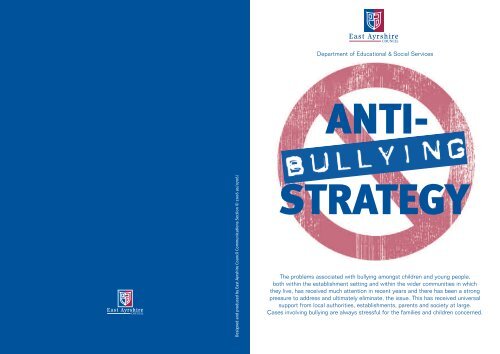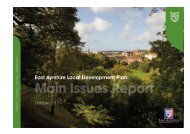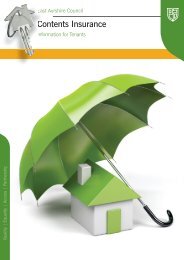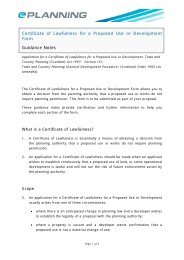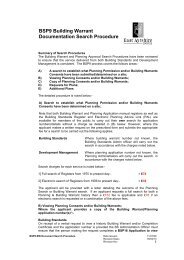Anti-Bullying strategy - East Ayrshire Council
Anti-Bullying strategy - East Ayrshire Council
Anti-Bullying strategy - East Ayrshire Council
- No tags were found...
You also want an ePaper? Increase the reach of your titles
YUMPU automatically turns print PDFs into web optimized ePapers that Google loves.
Department of Educational & Social ServicesANTI-Designed and produced by <strong>East</strong> <strong>Ayrshire</strong> <strong>Council</strong> Communications Section © 2006 as/0706/STRATEGYThe problems associated with bullying amongst children and young people,both within the establishment setting and within the wider communities in whichthey live, has received much attention in recent years and there has been a strongpressure to address and ultimately eliminate, the issue. This has received universalsupport from local authorities, establishments, parents and society at large.Cases involving bullying are always stressful for the families and children concerned.
ANTI- STRATEGY ANTI- STRATEGYThe Scottish <strong>Anti</strong>-<strong>Bullying</strong> Network (www.antibullying.net) is an excellent sourceof information, resources, advice and useful links for authorities, professionals,establishments, parents and children. <strong>East</strong> <strong>Ayrshire</strong> <strong>Council</strong> fully endorses the workof <strong>Anti</strong>-<strong>Bullying</strong> Network in all its forms. Its use by professionals, parents, childrenand young people is encouraged.The Position In <strong>East</strong> <strong>Ayrshire</strong>ANTI-There are many definitions of bullying. For educational purposes one of the most usefulis one provided by the Scottish <strong>Anti</strong>-<strong>Bullying</strong> Network: “<strong>Bullying</strong> is long-standingviolence, physical or psychological, conducted by an individual or group against anindividual who is not able to defend himself in the actual situation”. (Roland and Munthein “<strong>Bullying</strong>, an International Perspective). Importantly, many workers also identifybullying by its disproportionate effect on the victim.There is no evidence to suggest that the incidence of bullying is higher in <strong>East</strong> <strong>Ayrshire</strong>than in any other part of Scotland. Neither is there any evidence that incidences of bullyingare higher in any specific <strong>Council</strong> area or in any establishment than would be foundelsewhere. Notwithstanding this, the education authority is committed to taking the issueof bullying seriously and to ensuring the resources and supports are deployed where theyare needed in order to address the problem of bullying.STRATEGYWithin <strong>East</strong> <strong>Ayrshire</strong> the application of the <strong>Anti</strong>-<strong>Bullying</strong> <strong>strategy</strong> requires to takeaccount of all relevant legislation such as:• Children (Scotland) Act 1995• Standards in Scotland’s Establishments etc. Act 2000• Education (Additional Support for Learning) (Scotland) Act 2004Every establishment within <strong>East</strong> <strong>Ayrshire</strong> is required to have an <strong>Anti</strong>-<strong>Bullying</strong>Policy, or equivalent, based on the guidance outlined in this policy paper.In particular, such policies should be part of a whole establishment approach andshould consider:• Setting an establishment ethos which rejects bullying• Encouraging the reporting of bullying incidents• Raising awareness amongst staff, parents and pupils around the whole issueof bullying• Articulating the links between the formal and the informal curriculum regardingissues of bullying• Providing appropriate support for bullied children and for children who maythemselves be engaged in bullying others23
ANTI- STRATEGY ANTI- STRATEGY• Mobilising the strengths of the silent majority in all establishments whoreject bullying• Challenging and changing bullying behaviour when it is identified• Being aware of the links between possible racial incidents and bullying• Communicating establishment policy on bullying clearly and unambiguously tostaff, parents, children and young people• Having a clear system for logging and monitoring incidents of bullying and ofevaluating the effectiveness of steps taken to tackle incidents (see Appendix 1)In accordance with national regulations all establishments should have a planned,active and effective programme of playground supervision monitored by promoted staff.Preventative measures should include consideration of vulnerable, or unsupervised areasin the establishment, particularly toilet areas.All establishments must include a clear statement of their anti-bullying policy in theirhandbook. However, it is noted that having a policy in itself is not enough. Seniorestablishment staff will be expected to communicate and reinforce the contents of theestablishment policy in an effective manner in order to ensure that staff and pupils areclear what actions are expected of them should incidents of bullying occur.In addition, the SCRE document “<strong>Bullying</strong> at School” identifies a number of usefulmeasures that establishments can use to assist in incident of bullying. Among themost useful of these measures are:• Counselling from appropriately trained staff• Mediation with the help of a neutral third party• Peer counselling where older teenagers support younger pupils• Buddying schemes were vulnerable children are paired with an older pupil whoacts as a caring friend• Induction schemes for children joining a new establishment which are sensitiveto anti-bullying issues• Adoption of a general approach to the problem of bullying based on:- Honesty – an acknowledge that the problem exists- Openness – encouraging young people to talk openly about bullying- Involvement – recognising that everyone has a part: teachers, parents,pupils and ancillary staffIn the majority of cases involving allegations of bullying which come to theattention of senior officers and Heads of Service within the Department ofEducational and Social Services, the main issue is often not so much the bullyingincident but the manner in which the establishment dealt with the incident. Mostparents accept that it is not possible to wholly eradicate bullying. Concerns onlyemerge if the establishment is perceived (rightly or wrongly) not to be takingeffective action. It is therefore essential that establishment policies and proceduresare clear and unambiguous and that all parents are made aware of them. In thisway it will be clear to all parties what steps are being taken should an incident ofbullying occur. Establishments are therefore encouraged to:• Publicise their anti-bullying policy and procedures to all parents• Be aware that bullying can encompass a wide range of overt and covertbehaviours, attitudes, biases and stereotyping• Be sensitive to the potential for bullying around issues of disability, race,ethnicity, religious belief and sexual preference (homophobia)• Make it clear to all parents that all reported incidents of bullying will befully investigated• Clarify that appropriate actions will be taken in all cases• Commit to keeping parents fully apprised of establishment actions and theirsubsequent outcomes• Consult parents and the establishment boards (or equivalent) when developingor reviewing the policy.In dealing with bullying incidents establishments should as a first stage identifywhether the matter should be handled under this policy, or under conventionaldisciplinary arrangements. In general, cases that display one or more of thefollowing characteristics should be considered as bullying:• An element of pre-meditation based on a claimed dislike of a particularindividual or group• A series of incidents against a particular victim over a period of time• A series of incidents against a number of individual children over a period of time• Disproportionate aggression such as an older child picking on a youngerchild/children• Psychological aggression such as ostracism, whispering campaigns, maliciousstory-telling• Use of a proxy aggressor such as an older brother, sister or parent or maliciousstory telling to establishment staff• Group or gang violence against an individual or smaller group45
ANTI-STRATEGYANTI-STRATEGYThe national code of practice “Supporting Children’s Learning” suggests that a bulliedchild may have additional support needs within the terms of the Education (AdditionalSupport for Learning) (Scotland) Act 2004. Accordingly, establishments require aformalised way of assessing children against this possibility. The case of children who aresubject to severe bullying, or who are recurrently victimised should be considered by aestablishment assessment team, with a view to involving planned measures of supportusing the strategies in paragraph 3.6 above.Summary<strong>East</strong> <strong>Ayrshire</strong> <strong>Council</strong> remains committed to supporting establishments, parentsand young people deal with the consequences of bullying in the most supportiveand effective manner. To this end, there will be a regular review of the training andsupport needs of establishments and every effort will be made to ensure that allestablishments have access to appropriate quality training on an on-going basis.ANTI-Graham ShortExecutive Director of Educational & Social ServicesJune 2006STRATEGY67


